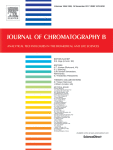- EN - English
- CN - 中文
BMV Propagation, Extraction and Purification Using Chromatographic Methods
雀麦花叶病毒的繁殖,提取及色谱法纯化
发布: 2018年07月20日第8卷第14期 DOI: 10.21769/BioProtoc.2935 浏览次数: 6621
评审: Vamseedhar Rayaprolu Joanna Sztuba-SolinskaJolene Ramsey

相关实验方案

诱导型HIV-1库削减检测(HIVRRA):用于评估外周血单个核细胞中HIV-1潜伏库清除策略毒性与效力的快速敏感方法
Jade Jansen [...] Neeltje A. Kootstra
2025年07月20日 1994 阅读
Abstract
Brome mosaic virus (BMV) is a well-known plant virus representing single-stranded RNA (ssRNA) positive-sense viruses. It has been widely used as a model in multiple studies concerning plant virus biology, epidemiology and the application of viral capsids in nanotechnology. Herein, we describe a method for BMV purification based on ion-exchange and size-exclusion chromatography. The presented method is of similar efficiency to previously described protocols relying on differential centrifugation and can easily be scaled up. The resulting BMV capsids are stable and monodisperse and can be used for further applications.
Keywords: Brome mosaic virus (雀麦花叶病毒)Background
One of the key challenges for nanotechnology to overcome is elaboration of effective and tissue-specific drug delivery methods. Plant viruses and virus-like particles (VLPs) are biocompatible and biodegradable and do not contain pathogens hazardous to human or animal health, and are a safe alternative to the synthetic drug carriers which often activate an undesirable response of the immune system or accumulate in the body to toxic levels. Finally, the production of the viral capsids is relatively cheap and fast (Ren et al., 2007; Arcangeli et al., 2014).
Brome mosaic virus (BMV) of the Bromoviridae family is a good candidate for use as a nanoparticle carrier since it shows all of the abovementioned features and is one of the best-studied plant viruses (Figlerowicz, 2000; Alejska et al., 2005; Urbanowicz et al., 2005; Wierzchoslawski et al., 2006; Kao et al., 2011). It is a positive-sense RNA virus with a genome composed of three different RNA segments. Each genomic RNA is packed into a separate capsid. The capsids are morphologically indistinguishable although they differ with their biophysical and biological properties. The molecular weight of the BMV virion is 4.6 MDa, and its diameter is approximately 28 nm. The BMV capsid has a T = 3 icosahedral construction and is comprised of 180 19.4-kDa CP monomers (Ni et al., 2014; Vaughan et al., 2014).
Although a commercial usage of VLPs as drug carriers is a distant future goal, BMV-based VLPs have already been loaded with various nanoparticles. The most effective VLP formation was obtained when gold nanoparticles were coated with polyanions, such as carboxylated polyethylene glycol. However other nanoparticles, such as spherical and cubic iron oxide were also encapsidated in BMV-based VLPs (Dragnea et al., 2003; Chen et al., 2006; Huang et al., 2011; Guerrero et al., 2017). BMV capsids carrying quantum dots might find an application as luminescent bioprobes (Dixit et al., 2006). In addition, the encapsulation of a chromophore, indocyanine green, into empty BMV capsids has also been archived (Jung et al., 2011). All previous reports described BMV preparations that were purified by differential ultracentrifugation using sucrose or cesium chloride gradients. These methods, although generate excellent quality viral preparations, have quantitative limitations. In this protocol we describe an efficient (up to 0.2 mg of virus from 1 g of plant tissue), chromatography-based method of obtaining BMV of high purity and quality; this method is an easy alternative to existing methods. The produced BMV capsids show high monodispersity and structure-environment dependency, features that are crucial for the formation of functional VLPs (Strugala et al., 2017) (Figure 2). Similarly to previously described methods, our procedure can be applicable to the purification of other plant viruses of similar capsid size. For example, it was highly efficient for the purification of the red clover necrotic virus (RCNMV) and resulted with monodisperse viral preparations. Finally, our protocol might be easily adapted for larger-scale purification.
Materials and Reagents
Notes:
- Regarding the materials, reagents and equipment, a proper and comparable setup may be used.
- All prepared buffers should be filtered through a 0.45 μm filter. Additionally, buffers for Size Exclusion Chromatography should be degassed (Degassing process takes 1 h for 1 L buffer. Store degassed buffers at 4 °C, for 1 month).
- BMV propagation
- Pots (Floser, catalog number: BTS 10,5 ), H 80 mm, Ø 105 mm, vol. 0.46 L
- Garden trays, 60 cm Square Tray Black (Garland Products, catalog number: G191B )
- Soil (PPHU Socha, all-purpose garden soil pH 5.5-6.5), quartz sand (PPHU Socha, 1mm diameter)
- Gloves (Mercator medical, Nitrylex PF classic)
- Tips
5,000 μl (PZ HTL, catalog number: 35001 )
1,000 μl (OMNITIP, catalog number: 85710 )
200 μl (OMNITIP, catalog number: 83710 )
10 μl (OMNITIP, catalog number: 81710 ) - Barley (Hordeum vulgare) seeds
- BMV-infected plants (barley or Chenopodium quinoa)
- Carborundum F400 (KREMER POLSKA, catalog number: 58750 )
- Liquid nitrogen (Air Products, CryoEase)
- Sodium phosphate monobasic (Sigma-Aldrich, catalog number: S3139 )
- Magnesium chloride hexahydrate (MgCl2·6H2O) (Sigma-Aldrich, catalog number: M2670 )
- Inoculation buffer (see Recipes)
- Pots (Floser, catalog number: BTS 10,5 ), H 80 mm, Ø 105 mm, vol. 0.46 L
- BMV isolation from plants
- NalgeneTM Oak Ridge High-Speed PPCO centrifuge tube (Thermo Fisher Scientific, catalog number: 3119-0050 )
- Tips (see Materials and Reagents A5)
- NalgeneTM Polysulfone reusable bottle top filter, 500 ml, collar 45 mm (Thermo Fisher Scientific, catalog number: DS0320-5045 )
- Filters 0.45 μm, 47 mm (Merck, catalog number: HAWG047S6 )
- Liquid nitrogen or dry ice
- Sodium acetate (CH3COONa) (Sigma-Aldrich, catalog number: S2889 )
- Boric acid (H3BO3) (MP Biomedicals, catalog number: 194810 )
- Magnesium chloride hexahydrate (MgCl2·6H2O) (Sigma-Aldrich, catalog number: M2670 )
- Chloroform (Firma Chempur, catalog number: CHEM*112344305 )
- 30% polyethylene glycol 8000 (PEG 8000) (BioShop, catalog number: PEG800 )
- Sodium phosphate dibasic (Na2HPO4) (Sigma-Aldrich, catalog number: S3264 )
- BMV extraction buffer (see Recipes)
- 10x L buffer (phosphate buffer) (see Recipes)
- NalgeneTM Oak Ridge High-Speed PPCO centrifuge tube (Thermo Fisher Scientific, catalog number: 3119-0050 )
- BMV purification
- Discardit IITM 5 ml syringe (BD, catalog number: 309050 )
- 50 ml conical tubes (SARSTEDT, catalog number: 62.548.004 )
- Tips (see Materials and Reagents A5)
- Micro tubes 1.5 ml (SARSTEDT, catalog number: 72.690.001 )
- Amicon Ultra-15 Filters (Merck, catalog number: UFC910024 )
- Filters 0.45 μm, 47 mm (Merck, catalog number: HAWG047S6 )
- PP centrifuge tubes 12 x 75 mm (Bionovo, catalog number: E-1649 )
- Millex-HV Syringe Driven Filter Unit (Merck, Millex Filter, catalog number: SLHV013NL )
- DEAE-cellulose (Sigma-Aldrich, catalog number: D3764 )
- Sodium chloride (NaCl) (BioShop, catalog number: SOD001 )
- Trizma base (Sigma-Aldrich, catalog number: T1503 )
- Glycerol (Carl Roth, Rotipuran, catalog number: 3783 )
- Phosphate-buffered saline (PBS) (Thermo Fisher Scientific, catalog number: 18912014 )
- Discardit IITM 5 ml syringe (BD, catalog number: 309050 )
- BMV analysis
- Micro tubes 1.5 ml (SARSTEDT, catalog number: 72.690.001 )
- Tips (see Materials and Reagents A5)
- Quartz cuvette (Hellma, catalog numbers: 105.201-QS , 105.231-QS )
- 4-20% Mini-PROTEAN® TGXTM Precast Protein Gels, 10-well, 30 μl (optional, Bio-Rad Laboratories, catalog number: 4561093 )
- Rotiphorese NF-acrylamid/bis 19:1 (Carl Roth, catalog number: A516.1 )
- Sodium dodecyl sulfate (SDS) (Carl Roth, catalog number: 0183.2 )
- Ammonium persulfate (APS) (Sigma-Aldrich, catalog number: A3678 )
- TEMED (BioShop, catalog number: TEM001.50 )
- Perfect Tricolor Protein Ladder (EURx, catalog number: E3210-01 )
- SDS-PAGE sample loading buffer: NovexTM Tris-Glycine SDS Sample Buffer (2x) (Thermo Fisher Scientific, catalog number: LC2676 )
- PageBlueTM Protein Staining Solution (Thermo Fisher Scientific, catalog number: 24620 )
- Micro tubes 1.5 ml (SARSTEDT, catalog number: 72.690.001 )
Equipment
- Preparing Buffers–all the steps:
- Bottles
1 L (Kavalierglass, Simax, catalog number: 1632414321940 )
500 ml (Kavalierglass, Simax, catalog number: 1632414321500 )
250 ml (Kavalierglass, Simax, catalog number: 1632414321250 ) - Cylinders
500 ml (Kavalierglass, Simax, catalog number: 1632432111343 )
250 ml (Kavalierglass, Simax, catalog number: 1632432111238 )
100 ml (Kavalierglass, Simax, catalog number: 1632432111130 )
- Bottles
- BMV propagation
- Beakers
1 L (Kavalierglass, Simax, catalog number: 1632417010940 )
800 ml (Kavalierglass, Simax, catalog number: 1632417010800 )
600 ml (Kavalierglass, Simax, catalog number: 1632417010600 )
400 ml (Kavalierglass, Simax, catalog number: 1632417010400 )
250 ml (Kavalierglass, Simax, catalog number: 1632417010250 )
100 ml (Kavalierglass, Simax, catalog number: 1632417010100 ) - Ice bucket (Round Ice Bucket with Lid, 4 L) (Corning, catalog number: 432122 )
- Porcelain unglazed mortar (Conbest, catalog number: 891-03-220 ) and porcelain unglazed pestle (Conbest, catalog number: 892-03-135 )
- Pipettes
- Eppendorf Research® plus 0.5-5 ml (Eppendorf, model: Research® plus , catalog number: 3123000071)
- Discovery comfort DV1000 (PZ HTL, catalog number: 4046-DV )
- Discovery comfort DV100 (PZ HTL, catalog number: 4044-DV )
- Discovery comfort DV10 (PZ HTL, catalog number: 4042-DV )
- Discovery comfort DV2 (PZ HTL, catalog number: 4041-DV )
- Eppendorf Research® plus 0.5-5 ml (Eppendorf, model: Research® plus , catalog number: 3123000071)
- Fitotron® plant growth chamber (Percival Scientific, model: E41-L2 )
- Beakers
- BMV extraction from plants
- Pipettes (see Equipment B4)
- Porcelain unglazed mortar (Conbest, catalog number: 891-03-220 ) and porcelain unglazed pestle (Conbest, catalog number: 892-03-135 )
- Vortex (Reax control) (Heidolph Instruments, catalog number: 541-11000-00 )
- Centrifuge (Eppendorf, models: 5415 R , 5810 R )
- Laboratory scale (RADWAG Balances and Scales, model: PS 1000.R2 )
- IKA MS 3 digital shaker (IKA, model: MS 3 )
- Pipettes (see Equipment B4)
- BMV purification
- Barnstead GenPure LifeScience UV/UF (TKA Wasseraufbereitungssysteme, catalog number: 08.2204 )
- Versatile laboratory pump (PL 2/1) (AGA LABOR, model: Basic 36 )
- Ion Exchange Chromatography
- Peristaltic pump (Masterflex L/S, Easy Load II Head, Cole-Parmer, catalog number: EW-77200-50 )
- CrystalCruz® chromatography column 2.5 x 10 cm (Santa Cruz Biotechnology, catalog number: sc-205558 )
- Pipettes (see Equipment B4)
- Peristaltic pump (Masterflex L/S, Easy Load II Head, Cole-Parmer, catalog number: EW-77200-50 )
- Size-Exclusion Chromatography (SEC)
- HiPrep 16/60 Sephacryl S-500 HR (GE Healthcare, catalog number: 28-9356-06 )
- ÄKTAprime plus (GE Healthcare)
- HiPrep 16/60 Sephacryl S-500 HR (GE Healthcare, catalog number: 28-9356-06 )
- Barnstead GenPure LifeScience UV/UF (TKA Wasseraufbereitungssysteme, catalog number: 08.2204 )
- BMV analysis
- Concentration measurement
- Pipettes (see Equipment B4)
- Apparatus for SDS Polyacrylamide gel electrophoresis (PAGE) (Mini-PROTEAN® Tetra Vertical Electrophoresis Cell) (Bio-Rad Laboratories, catalog number: 1658004 )
- Mini-PROTEAN® Tetra Cell Casting Module (Bio-Rad Laboratories, catalog number: 1658013 )
- Power supply (Wealtec, model: ELITE 300 Plus )
- Multi Bio 3D (Biosan, catalog number: BS-010125 )
- Thermoblock (Biosan, model: Bio TDB-100 )
- BioPhotometer (Eppendorf, catalog number: 550507804 )
- Pipettes (see Equipment B4)
- DLS analysis
- Pipettes (see Equipment B4)
- Malvern Zetasizer μV (Malvern Instruments)
- Pipettes (see Equipment B4)
- Concentration measurement
Procedure
文章信息
版权信息
© 2018 The Authors; exclusive licensee Bio-protocol LLC.
如何引用
Strugała, A., Bierwagen, P., Rybka, J. D., Giersig, M., Figlerowicz, M. and Urbanowicz, A. (2018). BMV Propagation, Extraction and Purification Using Chromatographic Methods. Bio-protocol 8(14): e2935. DOI: 10.21769/BioProtoc.2935.
分类
生物化学 > 蛋白质 > 分离和纯化
微生物学 > 微生物-宿主相互作用 > 病毒
您对这篇实验方法有问题吗?
在此处发布您的问题,我们将邀请本文作者来回答。同时,我们会将您的问题发布到Bio-protocol Exchange,以便寻求社区成员的帮助。
提问指南
+ 问题描述
写下详细的问题描述,包括所有有助于他人回答您问题的信息(例如实验过程、条件和相关图像等)。
Share
Bluesky
X
Copy link











